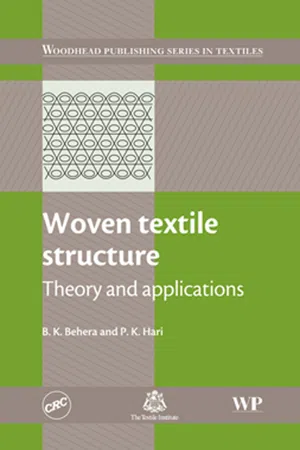Technology & Engineering
Poisson's Ratio
Poisson's ratio is a measure of the ratio of lateral strain to longitudinal strain within a material when it is stretched or compressed. It is a fundamental property of materials and is used to characterize their elastic behavior. Poisson's ratio is important in engineering and materials science for predicting how materials will deform under stress and designing structures to withstand such deformations.
Written by Perlego with AI-assistance
Related key terms
Related key terms
1 of 4
Related key terms
1 of 3
4 Key excerpts on "Poisson's Ratio"
- eBook - ePub
Woven Textile Structure
Theory and Applications
- B K Behera, P K Hari(Authors)
- 2010(Publication Date)
- Woodhead Publishing(Publisher)
τ ) within elastic limit is directly proportional to shear strain. Mathematically.where G is the constant of proportionality known as shear modulus.The SI unit of modulus of elasticity (E ) is the pascal, N/m2 . Modulus can be calculated from the slope of the straight-line portion of the stress–strain curve.7.2.5 Poisson ratio
Tensile or compressive axial strain is accompanied by lateral strain. The lateral strain is a fraction of the linear strain and within the elastic limit bears a constant ratio to the linear strain and is called the Poisson ratio. σ n represents the Poisson ratio for the lateral direction as it gives the contraction due to longitudinal extension. The suffixn is used for the direction in which contraction takes place due to extension in a longitudinal direction.7.2.6 Stress–strain diagram
The stress and corresponding strain when plotted on a graph constitute a stress–strain diagram. The diagram differs for different materials. A brittle material is one which gives very small deformation before fracture as shown in Fig. 7.3 .7.3 Stress–strain diagram for a brittle material.The yield point is defined as the stress beyond which a material deforms by a relatively large amount for a small increase in the stretching force. Beyond this stress, the material no longer obeys Hooke’s law.7.3 Tensile properties of woven fabrics
The tensile properties of woven fabrics produce several problems and complexities, mainly because the fabric is anisotropic and has a modulus which varies considerably with strain. The variation in the initial modulus is very large and the modulus in the warp and weft directions differs because the cloth is not symmetrical. In fact, the extension which takes place at an angle to the warp or weft is usually much higher and also involves a different mechanism of deformation [1 ]. For example, the modulus at an angle of 45° is mainly determined by the shear behavior. But if the extension is in the warp or weft direction, shear does not play any role. A woven fabric structure consists of fibers and yarns and its deformation results in a series of complex movement of fibers and yarns. The deformation behavior becomes more complex as both fiber and yarn behave in a non-Hookean manner. However, many researchers [2 –4 - Nuno M. Neves, Rui L. Reis, Nuno M. Neves, Rui L. Reis(Authors)
- 2016(Publication Date)
- Wiley(Publisher)
As depicted in panel C, the tangent modulus is taken as the slope of the stress–strain curve at some specified level of stress, while the secant modulus represents the slope of a secant drawn from the origin to some given point of curve. Other properties worth characterizing include: the Poisson's Ratio (υ), percent elongation (%EL), and moduli of resilience (Ur) and toughness (U T). The Poisson's Ratio is defined as the negative ratio between the lateral and axial strains that result from an applied axial stress, within the limits of an elastic deformation (for isotropic materials υ = –ϵ x /ϵ z = –ϵ y /ϵ z ; see Fig. 26.3, panel A for axes definition). Theoretically, the Poisson's Ratio for isotropic materials should be 0.25; meanwhile, the maximum value for υ (or that value for which there is no net volume change) is 0.50. The percent elongation is a measure of the degree of plastic deformation that has been sustained at fracture according to: %EL = 100(L f – L 0)/L 0, where L f and L 0 stand for the fracture length and the original gauge length of the sample, respectively. A material that experiences very little or no plastic deformation upon fracture (less than 5%) is termed brittle. Meanwhile, a material showing a large degree of plastic deformation is regarded as ductile. Finally, the moduli of resilience and toughness represent the strain energy per unit volume required to stress a material from an unloaded state up to the points of yielding and fracture, respectively. Numerically speaking, they correspond to the area under the curve from the origin to ϵ YP and ϵ B, respectively (see panel B). 26.2.5.2 Dynamic Tests Polymeric materials in general display a viscoelastic behavior. This is visible in quasi-static tensile tests because there is no linear region in the stress–strain curve (see Fig. 26.3, panel C)- eBook - ePub
- D.V. Rosato, D.V. Rosato(Authors)
- 2003(Publication Date)
- Elsevier Science(Publisher)
In the foregoing discussion the direction perpendicular to the plane of the plate has been neglected because the plate is assumed to be thin and the stresses are assumed to be applied in the plane of the plate rather than perpendicular to it. This assumption, which considerably simplifies the theory, carries through all of the following discussion. It is true, of course, that properties perpendicular to the plane of the plate are undoubtedly different than in the plane of the plate, and in thick plates this difference has to be taken into account, particularly when stresses are not planar.For isotropic materials, such as mat-reinforced construction, if E is the modulus of elasticity in any reference direction, the modulus E 1 at any angle to this direction is the same, and the ratio E 1 /E is therefore unity. Poisson’s ratio v is similarly a constant in all directions, and the shearing modulus G = E/ 2 (1 + v ). If v , for example, is 0.3, G/E = 0.385 at all angles. These relationships are shown in Fig. 2.33 .Figure 2.33 Modulus of elasticity, shear modulus, and Poisson’s ratio for isotropic material such as mat-reinforced plasticsThe following familiar relationships between direct stress σ and strain, ε, and shearing stress τ and strain γ hold:(2-88)(2-89)A transverse strain (contraction or dilation)εTis caused by σ equal to(2-90)For orthotropic materials, such as fabric and roving-reinforced construction,ELandETare the elastic moduli in the longitudinal (L ) and transverse (T ) directions,GLTis the shearing modulus associated with these directions,vLTis the Poisson’s ratio giving the transverse strain caused by a strett in the longitudinal direction, andvLTis Poisson’s ratio giving the longitudinal strain caused by a stress in the transverse direction. The modulus at any intermediate angle is E 1 , and if σ 1 is a stress applied in the 1-direction at an angle α with a longitudinal direction (Fig. 2.34 , top), the stress σ 1 causes a strain ε 1Figure 2.34 Elastic constants of unbalanced orthotropic material E 1 , G 12 , and v 12 are all functions of the angle between direction of stress and the longitudinal axis (warp direction) of the material. Factorsm1andm2 - eBook - ePub
- Karl J. Niklas, Hanns-Christof Spatz(Authors)
- 2012(Publication Date)
- University of Chicago Press(Publisher)
ν indicates a decrease in the resistance of a material to a change in volume and an increase in its ability to resist shear. Thus, over time and under a constant stress level, apple flesh appears to have the capacity to change its state from one tending to behave more like a liquid to one behaving more like a solid. This change in state appears to accelerate as the level of stress is increased. From a functional perspective, the alterations in the Poisson’s ratio reported for apple flesh could confer a mechanical benefit, since the tissue can resist shearing over relatively short intervals. More important, the behavior of apple flesh highlights the desirability of considering the Poisson’s ratios of organic materials as potential variables rather than as constants.Before leaving the general topic of Poisson’s ratio, it is worth noting that negative ratios are theoretically permissible for materials. That is, a material can expand orthogonally to the direction of an applied tensile load or can contract orthogonally to the direction of an applied compressive load. Negative Poisson’s ratios have been reported for some synthetic polymers whose polymeric units separate laterally as they are extended in length. Negative Poisson’s ratios have also been reported for some foams: commercially fabricated cellular solids with a beamlike or strutted infrastructure (Lakes 1987). The subject of cellular solids is treated in section 8.7 . It is also treated extensively by Gibson et al. (2010). These materials have numerous commercial applications, since they can inflate when they are pulled. They may also have botanical analogues. For example, some aerenchyma (a spongy tissue consisting of numerous strutlike interconnected cells) is anatomically similar to commercially fabricated foams. To our knowledge, no one has measured the Poisson’s ratios of aerenchyma or plant organs that characteristically have a spongy infrastructure consisting of many beams and struts attached to an external wall. However, since aerenchyma is attached to the walls of many otherwise hollow stems and leaves, and since these leaves and stems experience ovalization of the cross section when they are bent (see section 5.11
Index pages curate the most relevant extracts from our library of academic textbooks. They’ve been created using an in-house natural language model (NLM), each adding context and meaning to key research topics.
Explore more topic indexes
Explore more topic indexes
1 of 6
Explore more topic indexes
1 of 4



